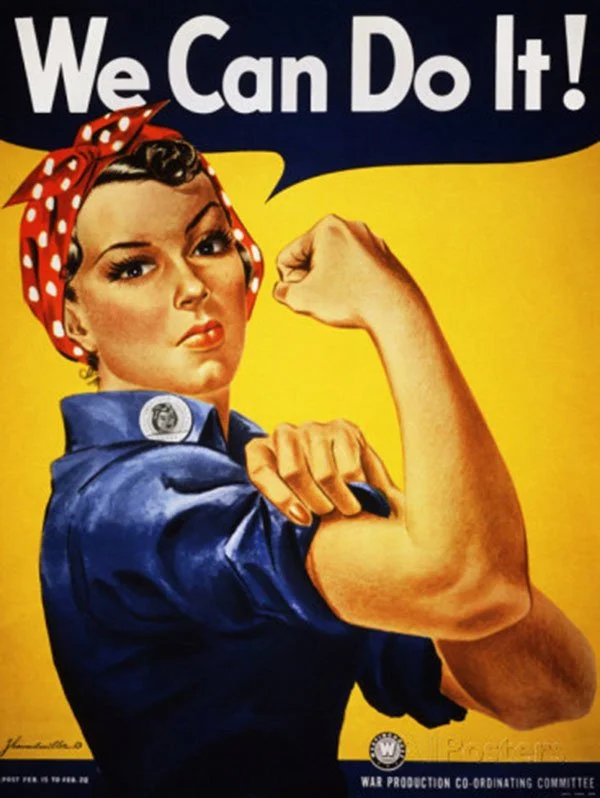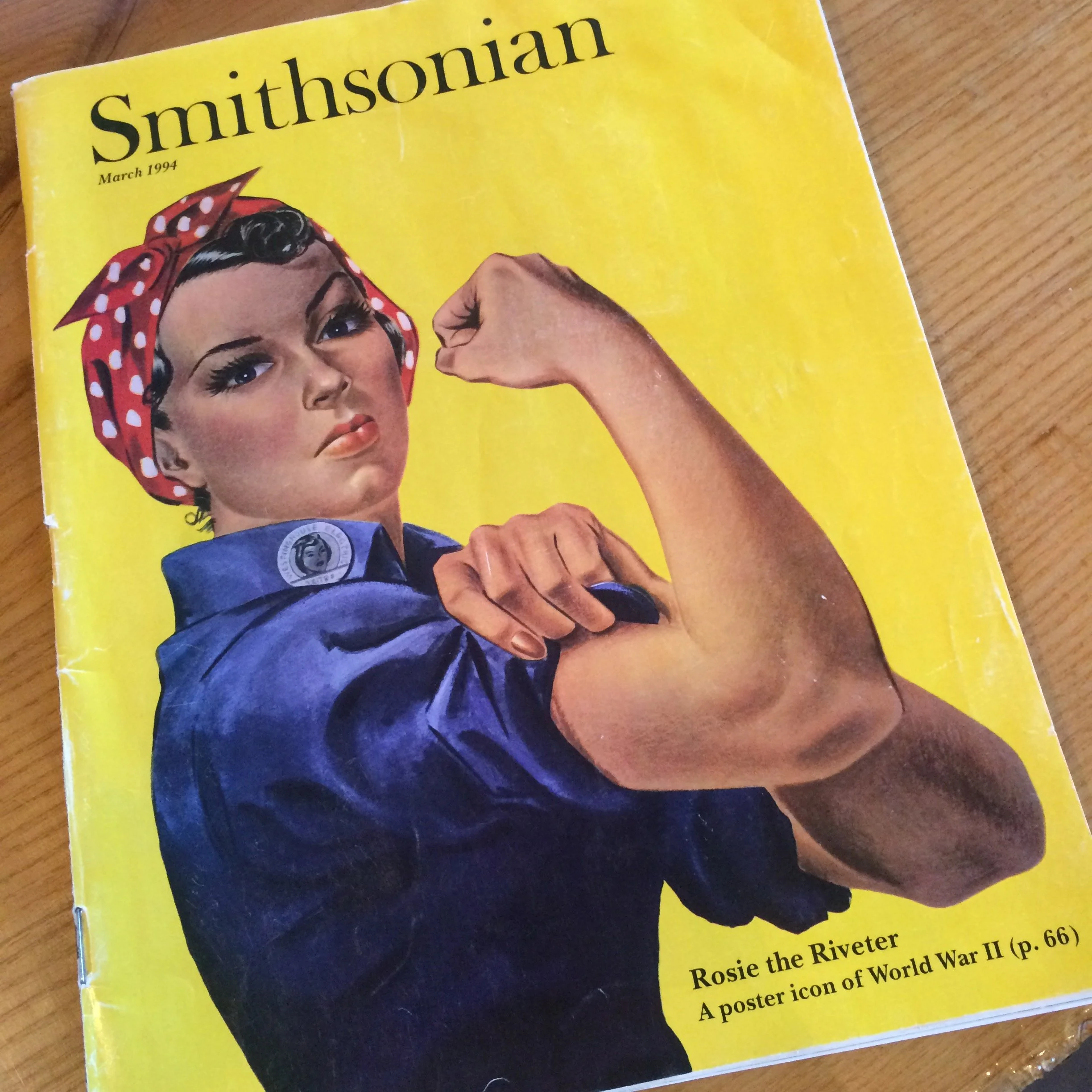"We Can Do it!" The Making of an Icon
How and when did the image that we refer to as “Rosie the Riveter” become so famous?
Although many sites and sources describe J. Howard Miller’s famous WWII-era “We Can Do It!” poster as government propaganda exhorting women to join the industrial workforce, and imply that it was a common sight during the war, it was in fact neither!
This poster was actually seen by very few people during WWII and only became famous many decades later.
Origins at Westinghouse in PA
J. Howard Miller designed and illustrated this poster for Westinghouse, Inc. for display in their Pennsylvania factories during a 2-week period in February of 1943. Westinghouse, like most manufacturing companies, had fully converted to war production. The purpose of the poster was not to recruit anybody, as obviously its audience would already be employed at Westinghouse. The purpose of the series of posters to which it belonged was to boost worker morale and reduce absenteeism. Miller’s use of a female worker simply reflects that the government campaign to recruit women had already succeeded by early 1943, and women had become a fixture in the industrial workplace. And perhaps also to encourage new women workers to stick with a difficult and unfamiliar job.
Much is made of the fact that the woman in the poster was not a riveter, since Westinghouse did not employ them, and therefore is “not really Rosie the Riveter.” However, we must remember that then, as now, Rosie the Riveter was the nickname for any woman who joined the industrial workforce to help win the war. The catchy phrase encompassed all women war workers, and still does today. So it’s entirely fair to call her Rosie, in our opinion. We don’t look at photos of the amazing women welders in California and think, “They’re not really Rosie the Riveter.” They most certainly are!
An Icon is Born
With a small print run and display only at Westinghouse for a 2-week period, there is no way this poster could have been famous or well-known during the war. So when did it become an icon?
After its 2 week run in 1943, the poster languished in obscurity, with likely only a few examples remaining in archives and attics, for decades. However, by the end of the 20th century, it became one of the most recognized and celebrated works of art in the US (and the world.) How did that happen?
“Rosie” Resurfacing in the 70s – Maybe, But Probably Not
Many sources cite the resurgence of interest in this image as coinciding with the Women’s Movement of the 1970’s. The only credible source for this idea we can find is author Penny Colman, in her book, Rosie the Riveter: Women Working on the Home Front in World War II, originally published in 1995. We’ll examine this idea in more detail later.
A more likely timeline for the reappearance of this famous “Rosie” is the 1980s, when the first wave of the feminism was already in full swing. Researchers James Kimble and Lester Olsen, who have done extensive research on this poster, cannot find reference to it in either scholarly literature or mass media before the 1980s. They specifically mention scholar Leila Rupp’s 1978 research on the topic, Mobilizing Women for War, wherein she discusses several versions of “Rosie’s” image but does not mention the Miller poster. They conclude that it is because the poster had not resurfaced yet, and Rupp was not aware of it.
In fact, the earliest mention or reproduction of “We Can Do It!” that Kimble and Olsen could find is in a March 1982 issue of the Washington Post Magazine, where it was featured as a reproduction image available from the National Archives. This one mention would hardly have catapulted it to fame.
The next mention Kimble and Olsen found was in a 1985 article in U.S. News and World Report, again probably not the trigger for the image’s great popularity.
Somehow, after these widely-spaced and little-noted 1980s mentions, and before the turn of the 21st century, Rosie became ubiquitous. But, when and how?
Coleman is probably correct in that public awareness of the image had its roots in its use by the Women’s Movement as a symbol of female capability and power. If Coleman, writing in 1995, and a feminist and a scholar herself, was aware of the image as a having a history of use within the Movement, we must take her word for it. But perhaps by 1995, she couldn’t be sure of when the poster first became associated with the Women’s Movement, and dialed it back to the Movement’s beginnings in the 1970s. According to Kimble and Olsen’s search of the public record, the feminists are more likely to have adopted the image later, in the 1980s.
The 1990s – Finally, Everything’s Coming Up Rosie!
The real tidal wave of “Rosie Awareness,” and mass reproduction of the “We Can Do It!” image came in the 1990s, spurred by its publication on the cover of Smithsonian Magazine’s March, 1994 issue.
The Smithsonian magazine enjoyed a large audience, and the image’s undeniable power spoke to viewers everywhere. And since the image was owned at this point by the National Archives (the rights having been transferred by Miller’s estate) and thus not under copyright, everyone from activist organizations to t-shirt sellers to event promoters was able to reproduce it without fear of copyright infringement. This is when the image that has come to be most closely associated with Rosie the Riveter really took off.
Sources for this article include:
Rosie the Riveter: Women Working on the Home Front in World War II by Penny Colman, originally published in 1995. Great book, get it on Amazon by clicking here.
Visual Rhetoric Representing Rosie the Riveter: Myth and Misconception in J. Howard Miller’s “We Can Do It!” Poster by James J. Kimble and Lester C. Olsen, originally published in the Journal of Rhetoric and Public Affairs, 2006.
Learn more about the very talented J. Howard Miller:
Click here to read a wonderful blog post by a Pittsburgh artist who knew Miller.


